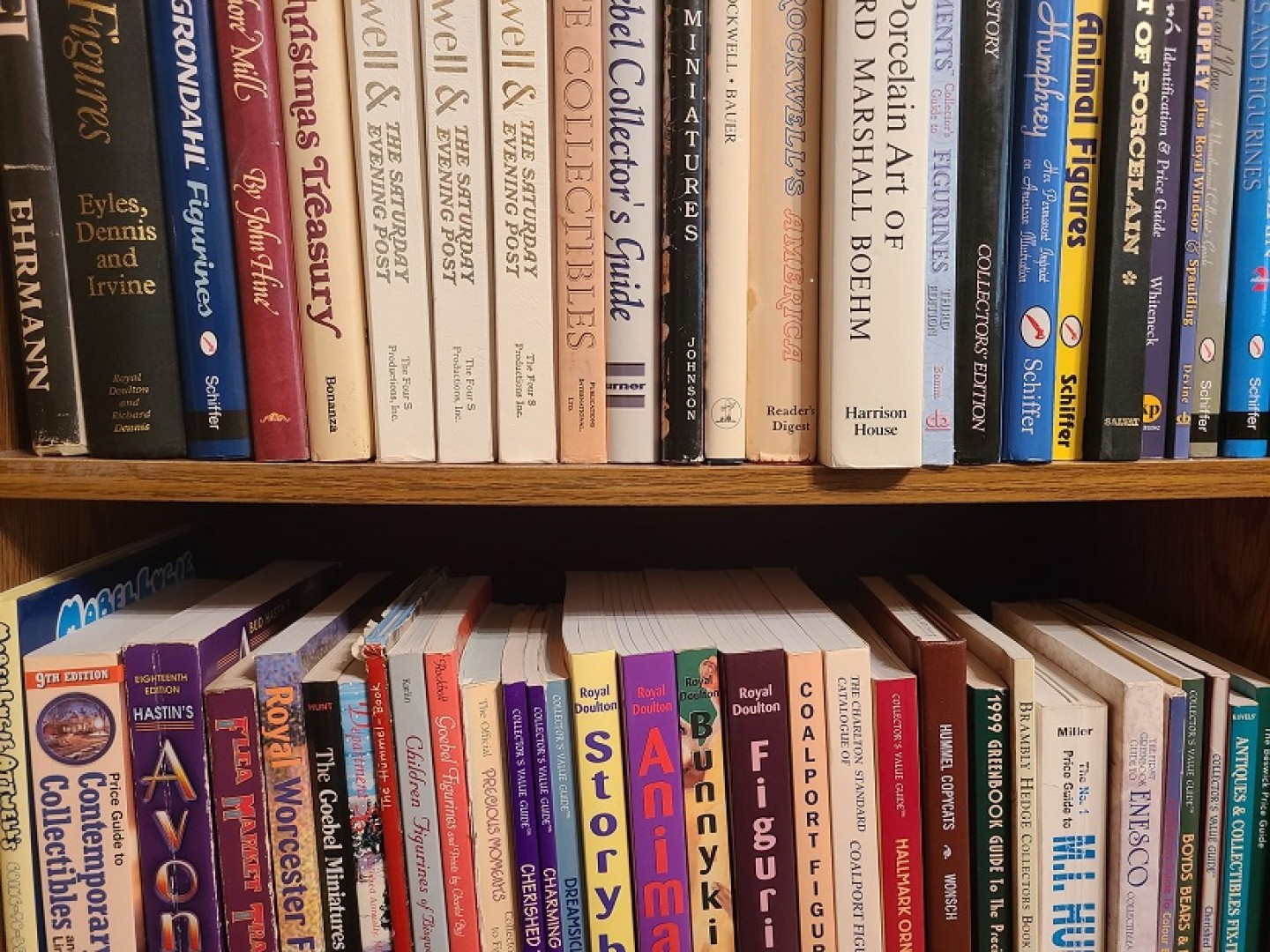This glossary is provided as a guide to some of the terms used throughout the woolvey.com website in describing items for sale and in reference guides. If you see another term referenced that you do not fully understand and is not explained below or if you require any further information about the terms below, please use the contact us page to let us know.
After Market
See Secondary Market
Airholes
Airholes are intentional holes in hollow ceramic pieces that allow air to escape during the firing process. Any air trapped without a means of escape will expand and cause the piece to break. Airholes are usually located on the base of an item or in another location where they are not immediately visible when the item is on display.
Backstamp
The term 'backstamp' is used to describe any manufacturer markings on the base or back of an item. It may include the manufacturer name or logo, product number or reference, artist information, dates or any other information that might help identify an item.
Bisque
Also called biscuit or biscuitware, bisque refers to clayware that has been fired for hardening but left unglazed.
Chip
A chip represents any minor damage to a ceramic item where the glaze and paint are missing (chipped away).
Crack
A crack in a ceramic item is a break caused by stress on the item. It is larger than the fine lines of crazing and usually results from mishandling.
Crazing
Crazing is the appearance of fine cracks in the glaze of ceramics. It results from unequal shrinking of the glaze and the body of the item. It is usually found more in older pieces but can be found in newer pieces too and is more likely if the item is exposed to extreme temperatures or changes in temperature. Although generally collectors prefer not to see crazing, some see crazing as proof of antiquity and some manufacturers have intentionally tried to create this effect in new pieces.
Discontinued
This is another term for retired. The manufacturer is no longer continuing to produce an item that is discontinued.
Earthenware
Earthenware is clay that is fired at lower temperatures than china. It is a porous material that may be glazed or unglazed.
Exclusive
This term is often used to describe items that are produced for a specific delivery sales channel. A company may approach a manufacturer to produce a particular item that will be sold exclusively through their sales channels. Such pieces may bear markings to indicate the exclusive nature of the item. Due to the limited availability of this type of item, they often have more rarity and greater value.
Flambé
Derived from the French word for "flamed", flambé refers to a style of glazing that produces a blood red finish, mottled with black. The flame effect is expensive to produce using copper oxide and oxygen, and produces somewhat unpredictable results.
Glaze
A glaze is a liquid finish that is applied to an item, which is then fired. The glaze protects the item, making it non-porous and more resistant to wear and damage. It may also be used for decorative purposes, providing luster, color or other effects.
Gres
A glaze technique that produces a smooth matte finish with excellent durability and abrasion resistance. The technique relies on variable degrees of crystallization in firing, producing somewhat unpredictable results, usually in earthy gray and brown colors.
Limited Edition
A limited edition piece is one that the original manufacturer produces in a predefined limited quantity or for a very limited period of time (usually also predefined). These pieces are sometimes uniquely numbered and often come with certificates of authenticity bearing the same unique number. Limited edition pieces are generally more sought after by collectors and tend to command a higher price.
Manufacturing Defect
Sometimes an item will pass the manufacturer's quality control checks but still have some type of flaw. These are usually minor flaws but evident as defects in manufacture because they appear under the glaze.
Matte
This term refers to any non-glossy, non-shiny finish. A dull, flat or satin appearance is generally referred to as matte.
Out of Production
This term indicates that an item is no longer being produced by the manufacturer. It is synonymous with retired.
Porcelain
Porcelain is a form of pottery that is white and highly durable with a hard glassy surface. Three primary ingredients; kaolin, quartz and feldspar, give porcelain its tough and attractive properties.
Rare
The term 'rare' is often used to describe antiques and collectibles. It is intended to indicate that an item of this type is seldom found. The rarity of a piece is often evident from being produced in a very limited quantity or produced for just a short period of time. Older items will generally have a greater rarity than newer items but it is true to say that, in most cases, nobody knows exactly how many of a particular piece still exist and therefore its rarity is often debatable.
Rattle
Occasionally with hollow ceramic items, small pieces of clay may drop off inside a piece as it is being fired. This may result in a small trapped piece inside the item that causes a rattle when the piece is moved. This does no harm to the piece and does not usually affect the value.
Reinstated
This term indicates that a piece was returned to production after previously being classified by the manufacturer as a non-production item.
Restoration
This term refers to the fixing of a defect in an item. Because ceramic items are so delicate it is not unusual for them to be accidentally broken. Often the damage is repairable to a degree where the item retains much, if not all, of its original charm. Restoration can be anything from an amateur using a 'super glue' to reattach a head to a more professional and almost undetectable restoration. If we ever list a restored piece on this website, it will be clearly stated because any restored piece has a lower value than an original 'perfect' piece.
Retired
This term indicates that an item is no longer being produced by the manufacturer and therefore is now limited to the current number in circulation and only available on the secondary market. Note that some manufacturers will reinstate pieces after they have been retired for a period of time. In some cases, the manufacturer will indicate at the point of retirement whether the retirement is permanent or whether there is a chance of future reinstatement.
Second
A 'second' is a piece that has some kind of flaw before it leaves the manufacturer. The flaw was created during the manufacturing process and identified by the manufacturer's Quality Control process. The flaw could be anything that the manufacturer deems to be less than the high-quality standards they want associated with their brand. Often it is something trivial and occasionally the difference may make a piece unique and even more desirable in some circles. Different manufacturers treat seconds differently. In some cases, the second is destroyed; in other cases, the manufacturers mark is scratched out on the base; in yet other cases it is marked as a second. No matter what method is used, many of these seconds find their way onto the secondary market. Any seconds listed on this website will be clearly stated as seconds.
Secondary Market
Secondary market refers to the buying and selling of items after the original retail transaction. This is effectively the re-selling of items and is the only means to obtain items that are no longer available through the official retail distribution channel. This is also referred to as the aftermarket.
Suspended
An item may be referred to as suspended if it is no longer being produced by the manufacturer but there is some chance that it may be produced again in the future. In some cases, this has the same meaning as retired or discontinued. Different manufacturers may give indications that an item is suspended indefinitely or for a temporary period before reinstatement.
Trademark
A trademark is any registered mark that indicates the manufacturer, publisher or other entity associated with an item. In the case of ceramic items, the trademark and backstamp are often interchangeable terms. The trademark may indicate the age/period, production facility or other identifiable information about an item as manufacturers change their trademark stamps over time.
©2007-2009 Woolvey LLC


